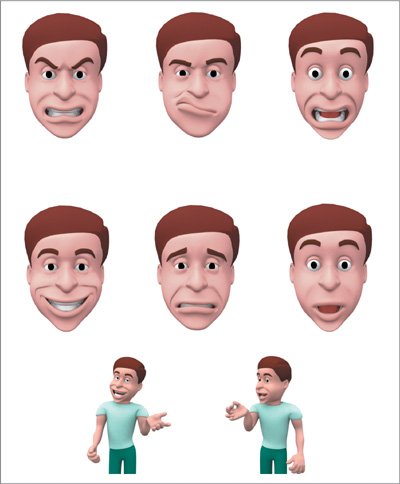Chapter Seven. Facial and Dialogue Animation
Seven Facial and Dialogue Animation

Animating the face is one of the most challenging and rewarding tasks you will encounter as an animator. It requires a good knowledge of facial anatomy as well as a strong understanding of how mood affects facial expression. Facial animation is also intimately involved with animating dialogue.
Dialogue animation is always depicted as one of the more difficult skills to master, but while it is difficult, having a voice for your character can also be very helpful to the animation process. Try communicating the same information contained within a line of dialogue with body postures aloneit's like trying to ask for the restroom in a country where you don't know the language.
Dialogue communicates volumes of information to the audience. It also gives the animator a lot to use when creating a scene. The dialogue has an emotional content and tone of voice as well as a distinct rhythm that the animator can use for timing. After analyzing the dialogue track, the animator should know exactly which parts of the dialogue to emphasize during the scene. Dialogue animation also requires a good eye and a thorough knowledge of acting and emotion.

Chapter One. Basics of Character Design
- Chapter One. Basics of Character Design
- Approaching Design as an Artist
- Design Styles
- Designing a Character
- Finalizing Your Design
Chapter Two. Modeling Characters
Chapter Three. Rigging Characters
- Chapter Three. Rigging Characters
- Hierarchies and Character Animation
- Facial Rigging
- Mesh Deformation
- Refining Rigs
- Conclusion
Chapter Four. Basics of Animation
- Chapter Four. Basics of Animation
- Understanding Motion
- Animation Interfaces
- The Language of Movement
- Secondary Action
- Conclusion
Chapter Five. Creating Strong Poses
- Chapter Five. Creating Strong Poses
- Posing the Body Naturally
- Creating Appealing Poses
- Animating with Poses
- Conclusion
Chapter Six. Walking and Locomotion
- Chapter Six. Walking and Locomotion
- The Mechanics of Walking
- Animating Walks
- Beyond Walking
- Adding Personality to a Walk
- Transitions
- Conclusion
Chapter Seven. Facial and Dialogue Animation
Chapter Eight. Animal Motion
Chapter Nine. Acting
- Chapter Nine. Acting
- Acting Vs. Animating
- Acting and Story
- Acting Technique
- Acting and the Body
- Other Techniques
- Conclusion
Chapter Ten. Directing and Filmmaking
EAN: 2147483647
Pages: 84
